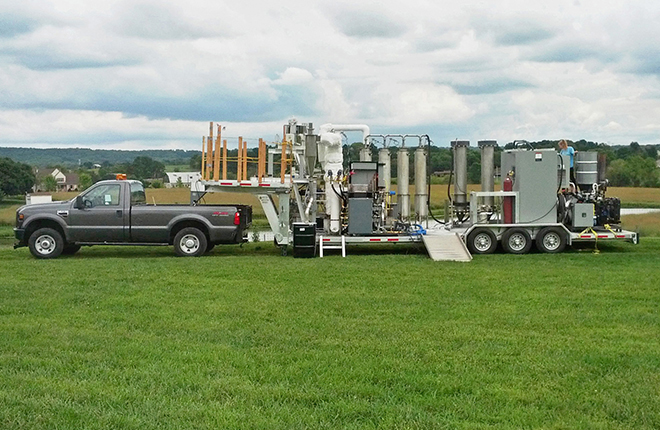Bringing Up Biofuel
Now, a team of Agricultural Research Service scientists in Wyndmoor, Pennsylvania, has made key advances in a process that produces a crude liquid called “bio-oil” from agricultural waste. The crude bio-oil is produced by pyrolysis, a process that involves chemical decomposition of plant and other organic matter using very high heat.
The modified technique is called “tail-gas reactive pyrolysis” (TGRP). It holds promise for processing and improving the bio-oil, which is ultimately processed into finished biofuel.
The Energy Independence and Security Act of 2007 calls for a minimum of 36 billion gallons of advanced biofuels to be produced in the U.S. by the year 2022. This effort will require, in part, the development of a new industry that produces 21 billion gallons of new biofuels based on non-food sources.
“Ideally, the biofuels added to gasoline would be identical to fuels produced at petroleum refineries,” says chemical engineer Yaseen Elkasabi. The research team, which includes Elkasabi, is headed by chemical engineer Akwasi Boateng with chemist Charles Mullen, and engineers Neil Goldberg and Mark Schaffer, in the Sustainable Biofuels and Coproducts Unit at the ARS Eastern Regional Research Center.
Raw material called “biomass” is the basis for producing biofuel, and it includes non-food-grade plant matter procured from agricultural or household waste. “We are using crop and forestry residue, such as wood and switchgrass, and also animal manures to produce bio-oils at an accelerated rate using a new high-output, mobile processing unit,” says Mullen. “Rather than shipping large amounts of agricultural waste to a refinery plant at a cost, the mobile reactor allows us to convert the biomass into a more energy-dense bio-oil right on the farm.” The goal of using TGRP on the farm is to yield a higher quality bio-oil that is more marketable to biofuel producers than bio-oil made from traditional pyrolysis methods.
Construction of the mobile unit was funded by a Biomass Research and Development Initiative grant from USDA’s National Institute of Food and Agriculture.
At petroleum refineries, distillation is a process used for preparing crude oils into finished fuels. But traditional petroleum refineries are not equipped to distill crude pyrolysis oil because it is highly acidic and has high oxygen content, making it corrosive and thermally unstable. Petroleum is naturally deoxygenated. While crude bio-oil can be deoxygenated by adding a catalyst, that approach is expensive and complex. The ARS team’s studies have shown that the new TGRP process provides bio-oils that are similar in composition and properties to those produced by adding the catalyst.
“The quality of TGRP deoxygenated liquids is equal to or better than the bio-oil produced by catalytic pyrolysis,” says Elkasabi. “TGRP is an important step toward the ultimate goal of producing cleaner bio-oils that can be distilled at existing petroleum refineries.”—By Rosalie Marion Bliss, Agricultural Research Service Information Staff.
“Bringing Up Biofuel” was published in the January 2016 issue of AgResearch Magazine.
Key Facts
- Biofuels are made from agricultural waste.
- The Energy Independence and Security Act calls for 21 billion gallons of advanced biofuels by 2022.
- ARS scientists improved the process to make biofuels, allowing bio-oil to be produced on farms.
Full Story







